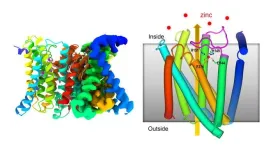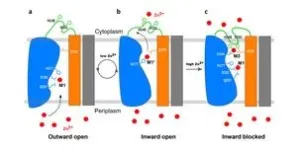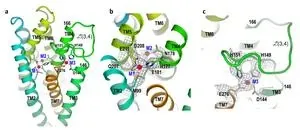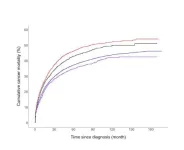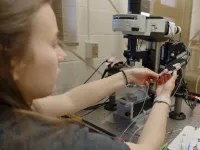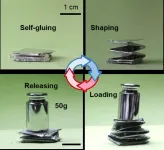(Press-News.org) UPTON, NY — Scientists at the U.S. Department of Energy’s (DOE) Brookhaven National Laboratory have determined the atomic-level structure of a zinc-transporter protein, a molecular machine that regulates levels of this crucial trace metal micronutrient inside cells. As described in a paper just published in Nature Communications, the structure reveals how the cellular membrane protein shifts its shape to move zinc from the environment into a cell, and temporarily blocks this action automatically when zinc levels inside the cell get too high.
“Zinc is important for many biological activities, but too much can be a problem,” said Qun Liu, the Brookhaven Lab biophysicist who led the project. “During evolution, different organisms have evolved in many ways to regulate zinc. But no one has shown that a transporter that controls the uptake of zinc from the environment can regulate its own activity. Our study is the first to show a zinc transporter with such a built-in sensor.”
The research was conducted as part of Brookhaven Lab’s Quantitative Plant Sciences Initiative (QPSI). Using a bacterial version of a zinc transporter that shares essential features with zinc transporters in plants, the scientists gained key insights into how these proteins work.
“This research is part of our effort to understand how micronutrients like zinc are taken up by plants so we can understand how to design plants that are better able to grow on marginal land for the production of bioenergy,” said Brookhaven Lab Biology Department Chair John Shanklin, a co-author on the paper.
The research could also suggest ways to engineer food crops with increased zinc content to improve their nutritional value, the scientists noted.
Cryo-EM plus computation
To solve the protein structure, the Brookhaven team used cryo-electron microscopy (cryo-EM) at the Laboratory for BioMolecular Structure (LBMS). With this technique, scientists can sample many different conformations of a protein instead of a single, crystallized form. That’s important because, in nature, proteins are dynamic, not static; pieces of them move around.
“Cryo-EM does not require proteins to form crystals, so we can actually capture dynamic steps that may not feasible using x-ray crystallography, another technique for studying protein structures,” Liu said. “In essence, with cryo-EM, we can capture more frames of the ‘movie’ to get a structure that is very helpful in understanding a protein’s biological function.”
To sort through the many variations in structure, the scientists need powerful computational tools. These include artificial intelligence approaches that use machine learning, some of which Liu has developed. Using these algorithms, the scientists can semi-automatically select and sort through millions of cryo-EM images to find groups of structures with similarities. The method allows them to achieve the highest feasible resolution, and thus to reveal atomic-scale details of the structure.
For this study, this cryo-EM approach revealed key features of one stage of a ZIP (Zrt-/Irt-like protein) zinc transporter that reveals how it regulates its own zinc-uptake activity depending on how much zinc is already in the cell.
“Our new data made us revise the previous views as to how this protein works,” Liu said.
Tilt to enter, sense to stop
An earlier report based on x-ray crystallography and coevolutional analyses suggested that the transporter may function as a sort of “elevator” to transport zinc. The new research shows how interactions with zinc on either side of the cellular membrane trigger the movement of parts of the protein to bring zinc into the cell—and, crucially, block its entry when the levels inside get too high.
“Our key structure shows that when the zinc level inside the cell rises to a certain level—beyond what’s required to meet the cell’s demands—the excess zinc binds to a loop on the inside of the membrane,” Liu said. “Then, as this flexible loop reorients, it folds back on itself, and binds in a manner that blocks zinc from entering the cell.”
“It’s almost like the plug going into a bathtub drain and blocking it,” Shanklin added.
The scientists also worked out how other parts of the protein move to allow zinc to enter.
When zinc levels inside the cell are low, zinc falls off the loop portion and the plug pops back out of the transporter. Zinc from the environment can move into the transporter. Inside the transporter, the zinc causes part of the protein machine to move up and tilt, closing the exit to the external environment. Once the zinc moves into the cell, the machine will reset itself to work again.
“Our cryo-EM structure is the first to show how this loop domain of the protein modulates the transporter’s activity by feedback depending on the level of zinc,” Liu said.
It’s also the first structure to show that this zinc transporter is an arrangement of two identical proteins—known as a dimer. “It requires two molecules to do the work,” Liu said.
The scientists’ think that having two molecules acting in the form of a dimer may be related to its function or stability—which they’ll explore with future computational simulations of how the molecules work together.
“This research could enable new ways of engineering zinc transporters in microbes and plants to optimize their growth in conditions where zinc is too low or too high, potentially on marginal lands for the production of bioenergy and bioproducts,” Liu said.
This research was funded by the DOE Office of Science, Office of Biological and Environmental Research (BER) through QPSI, with protein expression, purification, and sample preparation supported by the Office of Basic Energy Sciences (BES). LBMS operations are supported by BER.
Brookhaven National Laboratory is supported by the Office of Science of the U.S. Department of Energy. The Office of Science is the single largest supporter of basic research in the physical sciences in the United States and is working to address some of the most pressing challenges of our time. For more information, please visit science.energy.gov.
Follow @BrookhavenLab on Twitter or find us on Facebook.
Related Links
Scientific paper: "Structural Mechanism of Intracellular Autoregulation of Zinc Uptake in ZIP Transporters" END
Zinc transporter has built-in self-regulating sensor
New cryo-EM structure of a zinc-transporter protein reveals how this molecular machine functions to regulate cellular levels of zinc, an essential micronutrient
2023-06-09
ELSE PRESS RELEASES FROM THIS DATE:
New model offers a way to speed up drug discovery
2023-06-09
CAMBRIDGE, MA — Huge libraries of drug compounds may hold potential treatments for a variety of diseases, such as cancer or heart disease. Ideally, scientists would like to experimentally test each of these compounds against all possible targets, but doing that kind of screen is prohibitively time-consuming.
In recent years, researchers have begun using computational methods to screen those libraries in hopes of speeding up drug discovery. However, many of those methods also take a long time, as most of them calculate each target protein’s ...
Black, Hispanic survivors of breast cancer have higher death rates from second cancers
2023-06-09
Hispanic and non-Hispanic Black female survivors of breast cancer experience higher death rates after being diagnosed with a second primary cancer than members of other ethnic and racial groups, according to recent research from investigators at the Johns Hopkins Kimmel Cancer Center.
In a study of nearly 40,000 adult survivors of breast cancer, the risk of death from a second cancer was 12% higher among non-Hispanic Black survivors and 8% higher among Hispanic survivors compared with non-Hispanic white survivors. Survivors in racial and ethnic minorities were diagnosed with second cancers ...
Mouse models of adolescent binge drinking reveal key long-lasting brain changes
2023-06-09
UNIVERSITY PARK, Pa — Heavy alcohol consumption may cause permanent dysregulation of neurons, or brain cells, in adolescents, according to a new study in mice. The findings suggest that exposure to binge-levels of alcohol during adolescence, when the brain is still developing, lead to long-lasting changes in the brain’s ability to signal and communicate — potentially setting the stage for long-term behavioral changes and hinting towards the mechanisms of alcohol-induced cognitive changes in humans.
“What we’re seeing here,” said Nikki Crowley, assistant professor in biology and biomedical engineering ...
Infants and toddlers up to 5 years old can participate in Shape Up! Keiki study at Pennington Biomedical
2023-06-09
The Pennington Biomedical Research Center is looking for children 5 years old and younger to participate in the Shape Up! Keiki research study. The purpose of the Shape Up! Keiki research study is to create a better way to measure and describe health from body shape.
“Parents can learn more about their child’s health by joining the Shape Up! Keiki study, while also providing important information that will help us find quick ways to measure obesity status and health based on a child’s body ...
Seenu Hariprasad named University of Chicago Chair of Ophthalmology and Visual Science
2023-06-09
Seenu M. Hariprasad, MD, the Shui-Chin Lee Professor of Ophthalmology, will be appointed Chair of the Department of Ophthalmology and Visual Science, effective July 1, 2023. He has been serving as Interim Chair since 2020.
Hariprasad is an internationally recognized vitreoretinal surgeon who originally joined the University of Chicago in 2005. Over the course of his career, he has developed a strong track record as a clinician, surgeon, researcher, educator, and leader in his department. He is a leading specialist in various vitreoretinal disorders, including macular degeneration, diabetic ...
Liquid metal sticks to surfaces without a binding agent
2023-06-09
Everyday materials such as paper and plastic could be transformed into electronic “smart devices” by using a simple new method to apply liquid metal to surfaces, according to scientists in Beijing, China. The study, published June 9 in the journal Cell Reports Physical Science, demonstrates a technique for applying a liquid metal coating to surfaces that do not easily bond with liquid metal. The approach is designed to work at a large scale and may have applications in wearable testing platforms, flexible devices, and soft robotics.
“Before, we thought that it was impossible for liquid metal ...
Estimated reductions in opioid overdose deaths with public health interventions
2023-06-09
About The Study: In this decision analytical model study of the opioid epidemic in four U.S. states, sustained implementation of interventions, including increased delivery of medications for opioid use disorder and naloxone supply, was found to be needed to reduce opioid-related overdose deaths and prevent deaths from increasing again.
Authors: Jagpreet Chhatwal, Ph.D., of Massachusetts General Hospital in Boston, is the corresponding author.
To access the embargoed study: Visit our For The Media website at this link https://media.jamanetwork.com/
(doi:10.1001/jamanetworkopen.2023.14925)
Editor’s Note: Please see ...
Racial, ethnic, sex differences in methadone-involved overdose deaths before, after federal policy change expanding take-home methadone doses
2023-06-09
About The Study: In this study of monthly methadone-involved overdose deaths, the take-home policy may have helped reduce deaths for Black and Hispanic men but had no association with deaths of Black or Hispanic women or white men or women. The urgency of the overdose crisis requires that national methadone policy debates and decisions address the heterogeneity of people in treatment; relaxing methadone restrictions may help some particularly at-risk groups.
Authors: Rebecca Arden Harris, M.D., M.Sc., of the University of Pennsylvania in Philadelphia, is the corresponding author.
To ...
Graphene-based Carbocatalysts: Synthesis, Properties, and Applications—Beyond Boundaries
2023-06-09
Introducing "Graphene-based Carbocatalysts: Synthesis, Properties, and Applications (Volume 2)"—a concise yet comprehensive compendium for the scientific community, professors, and students alike. This authoritative volume - published by Bentham Science - delves into the forefront of Graphene-based carbocatalysis, providing a wealth of factual knowledge and exploration. The book opens with an in-depth analysis of electrocatalysis by Graphene materials, unraveling the intricate relationship between Graphene and electrochemical reactions. It sheds light on the catalytic prowess exhibited by Graphene-based materials, offering promising avenues for advancing energy ...
Aston University wins £1.8m to boost West Midlands low carbon markets
2023-06-09
Aston University and local industry to develop technology to convert organic material into commercially valuable products
Sawdust, diseased trees and dried chicken litter among what can be transformed into sustainable bioproducts
West Midlands companies are invited to join a cluster to develop new low carbon products for growing markets.
Aston University is to receive £1.8 million to transform the West Midlands into a powerhouse of low-carbon product development and commercialisation.
The University will be building on its existing research facilities to lead the region’s Biochar CleanTech Accelerator as part of the West Midlands Innovation Accelerator.
The project ...
LAST 30 PRESS RELEASES:
Sleeping in on weekends may help boost teens’ mental health
Study: Teens use cellphones for an hour a day at school
After more than two years of war, Palestinian children are hungry, denied education and “like the living dead”
The untold story of life with Prader-Willi syndrome - according to the siblings who live it
How the parasite that ‘gave up sex’ found more hosts – and why its victory won’t last
When is it time to jump? The boiling frog problem of AI use in physics education
Twitter data reveals partisan divide in understanding why pollen season's getting worse
AI is quick but risky for updating old software
Revolutionizing biosecurity: new multi-omics framework to transform invasive species management
From ancient herb to modern medicine: new review unveils the multi-targeted healing potential of Borago officinalis
Building a global scientific community: Biological Diversity Journal announces dual recruitment of Editorial Board and Youth Editorial Board members
Microbes that break down antibiotics help protect ecosystems under drug pollution
Smart biochar that remembers pollutants offers a new way to clean water and recycle biomass
Rice genes matter more than domestication in shaping plant microbiomes
Ticking time bomb: Some farmers report as many as 70 tick encounters over a 6-month period
Turning garden and crop waste into plastics
Scientists discover ‘platypus galaxies’ in the early universe
Seeing thyroid cancer in a new light: when AI meets label-free imaging in the operating room
Neutrophil-to-lymphocyte ratio may aid risk stratification in depressive disorder
2026 Seismological Society of America Annual Meeting
AI-powered ECG analysis offers promising path for early detection of chronic obstructive pulmonary disease, says Mount Sinai researchers
GIMM uncovers flaws in lab-grown heart cells and paves the way for improved treatments
Cracking the evolutionary code of sleep
Medications could help the aging brain cope with surgery, memory impairment
Back pain linked to worse sleep years later in men over 65, according to study
CDC urges ‘shared decision-making’ on some childhood vaccines; many unclear about what that means
New research finds that an ‘equal treatment’ approach to economic opportunity advertising can backfire
Researchers create shape-shifting, self-navigating microparticles
Science army mobilizes to map US soil microbiome
Researchers develop new tools to turn grain crops into biosensors
[Press-News.org] Zinc transporter has built-in self-regulating sensorNew cryo-EM structure of a zinc-transporter protein reveals how this molecular machine functions to regulate cellular levels of zinc, an essential micronutrient
